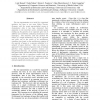Free Online Productivity Tools
i2Speak
i2Symbol
i2OCR
iTex2Img
iWeb2Print
iWeb2Shot
i2Type
iPdf2Split
iPdf2Merge
i2Bopomofo
i2Arabic
i2Style
i2Image
i2PDF
iLatex2Rtf
Sci2ools
FBIT
2007
IEEE
2007
IEEE
Unsupervised Learning in Spectral Genome Analysis
The tree representation as a model for organismal evolution has been in use since before Darwin. However, with the recent unprecedented access to biomolecular data it has been discovered that, especially in the microbial world, individual genes making up the genome of an organism give rise to different and sometimes conflicting evolutionary tree topologies. This discovery calls into question the notion of a single evolutionary tree for an organism and gives rise to the notion of an evolutionary consensus tree based on the evolutionary patterns of the majority of genes in a genome embedded in a network of gene histories. Here we discuss an approach to the analysis of genomic data of multiple genomes using bipartition spectral analysis and unsupervised learning. An interesting observation is that genes within genomes that have evolutionary tree topologies that are in significant conflict with the evolutionary consensus tree of an organism point to possible horizontal gene transfer event...
Evolutionary Consensus Tree | Evolutionary Tree | Evolutionary Tree Topologies | FBIT 2007 | Information Management |
| Added | 02 Jun 2010 |
| Updated | 02 Jun 2010 |
| Type | Conference |
| Year | 2007 |
| Where | FBIT |
| Authors | Lutz Hamel, Neha Nahar, Maria S. Poptsova, Olga Zhaxybayeva, J. Peter Gogarten |
Comments (0)

